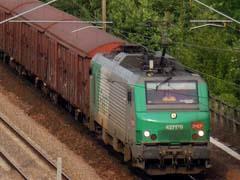
Wagonload accounts for 35% of tonnage hauled by Fret SNCF. It is also responsible for 70% of the losses that the business incurs every year. In a bid to turn it round once and for all, SNCF is relaunching its wagonload service in a project known as Swing (Service de Wagon Isolé de Nouvelle Génération).
Fret Director Luc Nadal says ‘2011 is a reasonable date for a return to breakeven’, but to achieve this means tackling the ‘commercial challenge and gaining the confidence of new customers’. It also demands reliable infrastructure to ensure timetable stability, ‘without which our new network will not function’.
Wagonload is used extensively in France by the steel, chemicals and automotive industries. These customers share with other users hopes of greater reliability, better information, shorter trip times, more favourable pricing and a desire for SNCF to react faster to problems or service requests.
In addressing these concerns, SNCF has come up with a reshaped network based on hubs at Villeneuve-Saint-Georges in the Paris suburbs, Woippy near Metz and Sibelin near Lyon; another hub at Gevrey near Dijon will provide overflow capacity. Linked by frequent shuttle services, the three main hubs will be fed by trains to and from 30 subsidiary yards serving industrial centres mainly in eastern, southeastern and northern France.
As an example, Woippy and Sibelin will be linked by seven regularly-scheduled shuttles every 24 h. If departures are not spread evenly, ‘the system does not make sense’, remarks Nadal.
A major departure from earlier practice is the allocation of a fleet of 90 locomotives dedicated to wagonload traffic. These locos will haul trains departing at regular intervals with connections that are designed to be more robust than in previous wagonload improvement projects, thanks in part to ‘quality paths’ which SNCF has agreed with RFF after careful assessment. The paths generally assume a maximum speed of 100 km/h, allowing an average speed of at least 75 km/h.
Customers will be able to choose from three levels of service. The ‘basic offer’ will apply to traffic accepted at short notice, and timings and priority levels will not be guaranteed in the event of disruption or lack of space on the trains — although service standards are expected to be higher than those pertaining until now.
A higher level of service will be available for irregular or one-off flows of traffic, with customers able to request service two days in advance. Contracts will put the onus on SNCF to meet specified timings.
The third level will provide a priority service available to customers able to predict their traffic in advance, and this will be used mainly by major clients, typically requiring a daily service.
Another key element in the Swing package is supervision. Managers based at Fret SNCF headquarters in Clichy-la-Garenne will be able to take advantage of a new intranet-based information system that gives them an overall picture of the service; it also allows them to ‘zoom in’ to check the progress of an individual wagon. Real-time information is supplied from eight outstations to ensure that managers have an accurate view of the status of services, loadings and the network.
The information system has absorbed nearly 30% of the €20m that SNCF has spent over the last two years putting Swing together. An initial contribution of €50m from SNCF has been channelled into improvements to the infrastructure specifically to benefit the wagonload business. However, Nadal is concerned that RFF will be carrying out a considerable amount of engineering work to fettle up or repair the national network, and he fears that this may affect reliability of the new service.
During 2009 SNCF will concentrate its efforts on developing a commercial policy that makes best use of the new service which is based on historic traffic flows. ‘With an 80% load factor the network loses money, but at 85% it is earning a profit’, affirms Nadal. This means that SNCF will be looking for new business which incurs no extra expenditure or just marginal costs. While there is apparent synergy with the Geodis road transport business, this will only be exploited at a later stage, says Nadal.
SNCF is examining links with wagonload services operated by other railways in Europe as 80% of wagonload traffic is international. One scheme in this context is the X-Rail project which national operators in Germany, Switzerland, Belgium, Austria and Sweden plan to launch in 2009.
‘Cultural revolution’ called off
Many of Fret SNCF’s hopes in turning round its loss-making wagonload business rested on productivity improvements that the railway had negotiated with its staff. At least, it thought it had, until two trade unions announced that they would withdraw their labour on November 18, swiftly followed by five others calling for a strike with effect from November 23. Management persuaded the first two unions to postpone their strike until November 21, but the delay was bought at some cost.
During earlier negotiations, staff had agreed to accept changes to working conditions, with around 920 out of around 2 200 drivers opting for night shifts to be lengthened from 6 h to 7 h 30 min, starting on December 14. The strike threat obliged SNCF to reopen the talks, as a result of which a compromise of 6 h 30 min was reached for night shifts. Other proposals to change working conditions were still being discussed as we closed for press.
Around 10 000 staff are involved in the wagonload business, and SNCF had hoped to persuade the unions to agree to changes in order to compete more effectively with open-access operators and road haulage. So much progress had been made that Jean-Claude Larrieu, Director responsible for the chemicals business and the wagonload sector, referred to ‘a real cultural revolution’. Regrettably, his comment seems to have been premature.




















